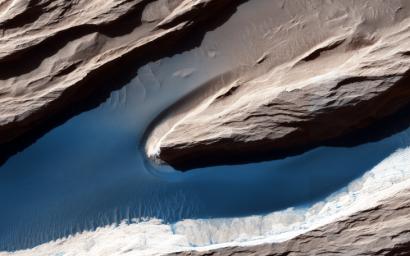
|
Wind at Work
- Click the image above for a larger view
- Full-Res JPEG (2880 x 1800) (554.4 kB)
- Full-Res TIFF (2880 x 1800) (15.0 MB)
Caption:

Map Projected Browse Image
Click on the image for larger version
Wind is one of the most active forces shaping Mars' surface in today's climate. The wind has carved the features we call "yardangs," one of many in this scene, and deposited sand on the floor of shallow channels between them.
On the sand, the wind forms ripples and small dunes. In Mars' thin atmosphere, light is not scattered much, so the shadows cast by the yardangs are sharp and dark . (Note: The cutout is not map-projected, so approximate north is down).
Background Info:
The University of Arizona, Tucson, operates HiRISE, which was built by Ball Aerospace & Technologies Corp., Boulder, Colo. NASA's Jet Propulsion Laboratory, a division of the California Institute of Technology in Pasadena, manages the Mars Reconnaissance Orbiter Project for NASA's Science Mission Directorate, Washington.
Cataloging Keywords:
| Name | Value | Additional Values |
|---|---|---|
| Target | Mars | |
| System | ||
| Target Type | Planet | |
| Mission | Mars Reconnaissance Orbiter (MRO) | |
| Instrument Host | Mars Reconnaissance Orbiter | |
| Host Type | Orbiter | |
| Instrument | High Resolution Imaging Science Experiment (HiRISE) | |
| Detector | ||
| Extra Keywords | Atmosphere, Color, Dune, Map, Shadow | |
| Acquisition Date | ||
| Release Date | 2016-02-11 | |
| Date in Caption | ||
| Image Credit | NASA/JPL-Caltech/Univ. of Arizona | |
| Source | photojournal.jpl.nasa.gov/catalog/PIA20461 | |
| Identifier | PIA20461 | |
